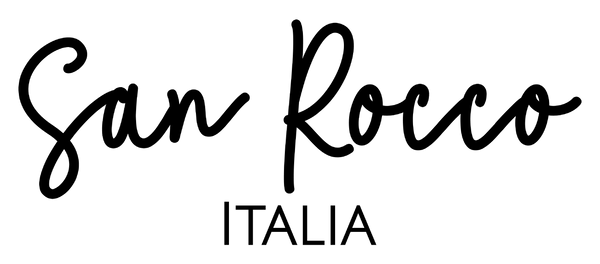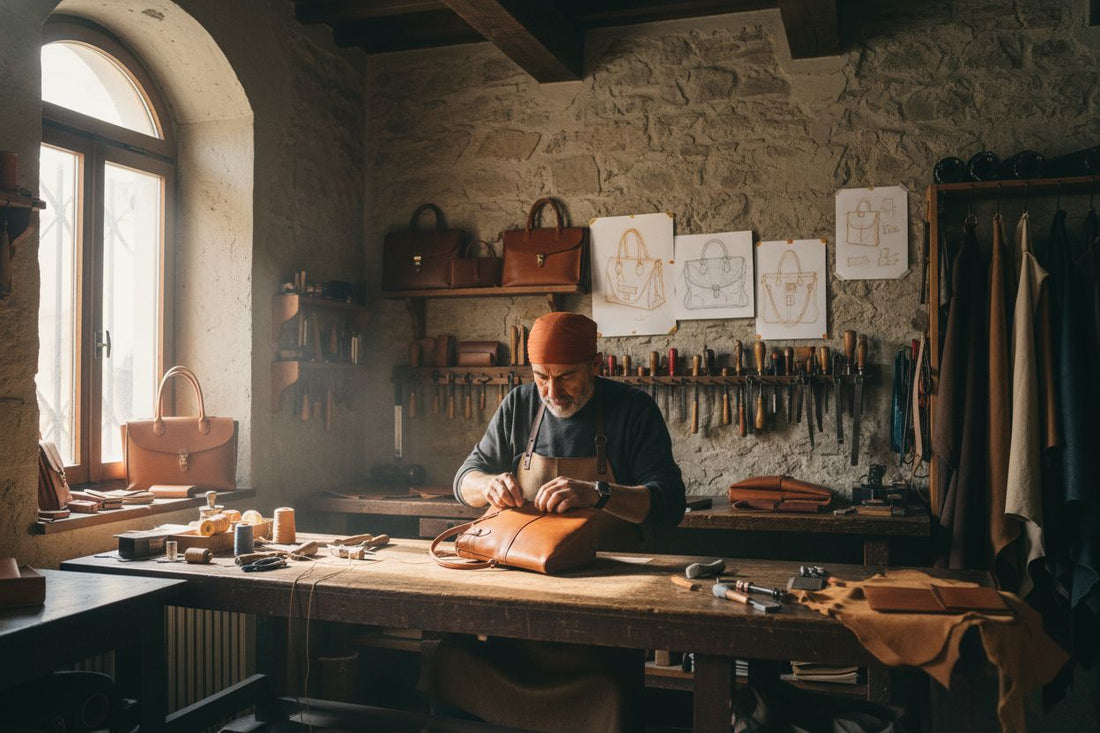
History of Italian Leather Goods Explained: Origins to Icons
Share
Did you know that Italy produces over 70 percent of the world’s high-end leather goods? For centuries, Italian artisans have turned simple animal hides into masterpieces that stand out in luxury markets worldwide. Generations of skill, local traditions, and innovation set Italian leather apart, making it a symbol of durability and artistry. This rich heritage shapes everything from classic handbags to cutting-edge sustainable designs, capturing the legacy and modern appeal of true Italian craftsmanship.
Table of Contents
- Origins Of Italian Leather Craftsmanship
- Evolution Of Artisanal Techniques And Styles
- Iconic Brands And Signature Italian Designs
- Full-Grain Leather: Characteristics And Quality
- Modern Trends And Sustainable Practices In Leather
Key Takeaways
| Point | Details |
|---|---|
| Origins of Craftsmanship | Italian leather craftsmanship has roots dating back to prehistoric eras, shaped by advancements in tool production and unique artisanal techniques. |
| Artisanal Techniques | Technological evolution in leather crafting is marked by complex manufacturing processes, leading to the emergence of regional specialties across Italy. |
| Iconic Brands | Renowned Italian brands like Bottega Veneta and Gucci represent a cultural narrative of luxury, combining artistic excellence with innovative design. |
| Sustainability Focus | The modern leather industry is shifting towards sustainability, emphasizing ethical production, alternative tanning methods, and longevity in leather products. |
Origins Of Italian Leather Craftsmanship
The profound history of Italian leather craftsmanship traces back to prehistoric eras, emerging from sophisticated tool production techniques developed during pivotal human migration and settlement periods. According to archaeological research, the transition from the Middle to Upper Palaeolithic in Italy represented a critical moment of technological advancement, establishing foundational skills that would eventually transform leather processing.
Early Italian artisans discovered remarkable methods of transforming animal hides into durable materials, developing intricate techniques that distinguished their work from other regional practices. These craftspeople understood the nuanced relationship between materials, environment, and human skill - treating leather not merely as a resource, but as a medium for artistic expression and practical utility.
The evolution of leather crafting in Italy was deeply connected to regional economic structures, particularly in areas like Tuscany and Lombardy, where local communities developed specialised knowledge passed through generations. Discover more about the intricate history of Italian leather craftsmanship and how these traditional techniques continue to influence modern luxury design.
By the Renaissance period, Italian leather production had become renowned worldwide, with sophisticated tanning processes, exceptional quality standards, and an emerging reputation for unparalleled artisanal skill. These early innovations laid the groundwork for what would become a global benchmark in leather manufacturing - a tradition of excellence that continues to define Italian craftsmanship today.
Evolution Of Artisanal Techniques And Styles
The evolution of Italian leather craftsmanship represents a remarkable journey of technological sophistication and artistic innovation. According to archaeological research, significant technological transformations occurred between 50,000 and 39,000 years BP, reflecting increasingly complex artisanal manufacturing processes. These periods, particularly the Uluzzian and Protoaurignacian eras, marked critical transitions in production techniques that would profoundly influence future leather crafting.
Traditional leather artisans developed intricate techniques that elevated their craft beyond mere functionality. They mastered nuanced processes of tanning, cutting, and treating leather, creating methods that transformed raw animal hides into exquisite, durable materials. Explore the comprehensive techniques of Italian leather making to appreciate the depth of this remarkable craftsmanship.
Regional specialisations emerged across different Italian territories, with each area developing unique styles and techniques. Tuscany became renowned for its vegetable tanning methods, while Venice developed exceptional techniques for creating soft, supple leather used in high-end fashion and accessories.
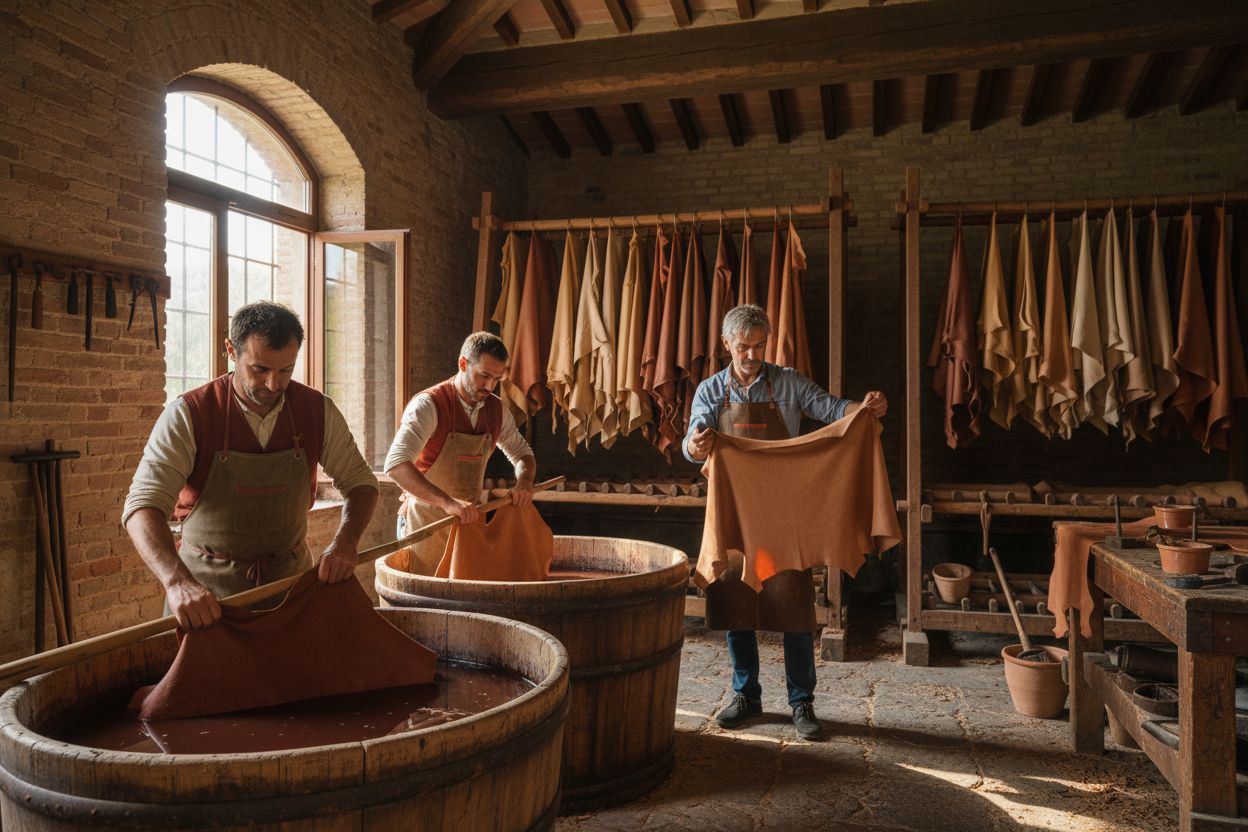 These regional variations contributed to Italy’s reputation as a global leader in leather craftsmanship.
These regional variations contributed to Italy’s reputation as a global leader in leather craftsmanship.
Here’s a comparison of key regional Italian leather crafting traditions:
| Region | Signature Technique | Renowned For |
|---|---|---|
| Tuscany | Vegetable tanning | Natural finish Durability |
| Venice | Soft leather techniques | Supple feel Luxury fashion |
| Lombardy | Specialised craftsmanship | Artisan knowledge Quality |
| Florence | Fine artisanal methods | Hand-stitched goods Heritage |
By the Renaissance, Italian leather artisans had established a global reputation for exceptional quality, innovative design, and meticulous attention to detail. Their techniques combined scientific precision with artistic expression, creating leather goods that were not just functional objects, but true works of art - a tradition of excellence that continues to define Italian leather craftsmanship today.
Iconic Brands And Signature Italian Designs
Italian luxury brands have long been synonymous with exceptional craftsmanship, transforming leather goods from mere accessories into statements of artistic excellence. Founded in 1966, Bottega Veneta exemplifies this tradition through its revolutionary Intrecciato leather weaving technique - a signature design that has become an iconic representation of Italian leather artistry.
The narrative of Italian luxury is deeply rooted in what researchers describe as ‘Italianicity’ - a profound commitment to craftsmanship that extends beyond production into brand identity. Discover the fascinating history of Italian handbag making and how these brands have shaped global perceptions of luxury design.
Each iconic Italian brand brings unique characteristics to leather design. Prada revolutionized minimalist aesthetics, Gucci introduced bold pattern work, and Fendi pioneered innovative leather treatments that transformed traditional manufacturing techniques. These brands didn’t just create products; they crafted cultural narratives that celebrated Italian design philosophy.
Beyond individual brands, Italian leather design represents a collective commitment to quality, innovation, and aesthetic sophistication. From meticulously hand-stitched leather bags to precisely engineered accessories, these brands continue to set global standards - proving that true luxury is not just about appearance, but about the intricate story woven into every carefully crafted piece.
Full-Grain Leather: Characteristics And Quality
Full-grain leather represents the pinnacle of leather quality, embodying a commitment to durability and natural beauty that has captivated artisans and luxury consumers alike. According to research, this premium leather type is prized for its exceptional strength and unique ability to develop a rich, distinctive patina over time, making each piece truly individual.
The characteristics of full-grain leather are remarkable. Unlike processed leathers, it retains the entire natural grain layer, preserving the hide’s most robust and resilient section. Learn how to identify authentic Italian leather and understand why discerning consumers seek out this exceptional material.
Sustainability has become a critical focus in leather production, with the fashion industry increasingly emphasizing high-quality materials that enhance product longevity. Full-grain leather perfectly embodies this approach, offering remarkable durability that reduces the need for frequent replacements and minimizes environmental impact.
The beauty of full-grain leather lies in its imperfections - natural markings, subtle variations, and unique textures that tell a story of origin and craftsmanship. Each piece develops character over time, becoming softer, more supple, and more beautiful with use - a testament to the extraordinary nature of this exceptional material.
Modern Trends And Sustainable Practices In Leather
The leather industry is undergoing a profound transformation, with sustainability emerging as a critical focus for modern manufacturers. According to recent research, the fashion industry is actively reshaping its operations to achieve more environmentally responsible production and consumption goals, signaling a significant shift in traditional leather manufacturing practices.
Explore the future of the Italian leather industry and discover how technological innovation is intersecting with traditional craftsmanship. Innovative approaches are now emerging, such as the integration of collaborative robotic systems in luxury leather production - a trend that maintains artisanal quality while embracing technological efficiency.
Sustainable practices now encompass multiple dimensions, from ethical sourcing of raw materials to implementing circular economy principles. Manufacturers are increasingly focusing on reducing environmental impact by developing alternative tanning processes, utilizing recycled materials, and creating leather products designed for longevity and minimal waste.
The modern leather industry represents a delicate balance between preserving traditional craftsmanship and embracing technological innovation. By prioritizing sustainable practices, ethical production, and technological advancement, Italian leather manufacturers are redefining luxury - creating products that are not just beautiful, but also responsible and forward-thinking.
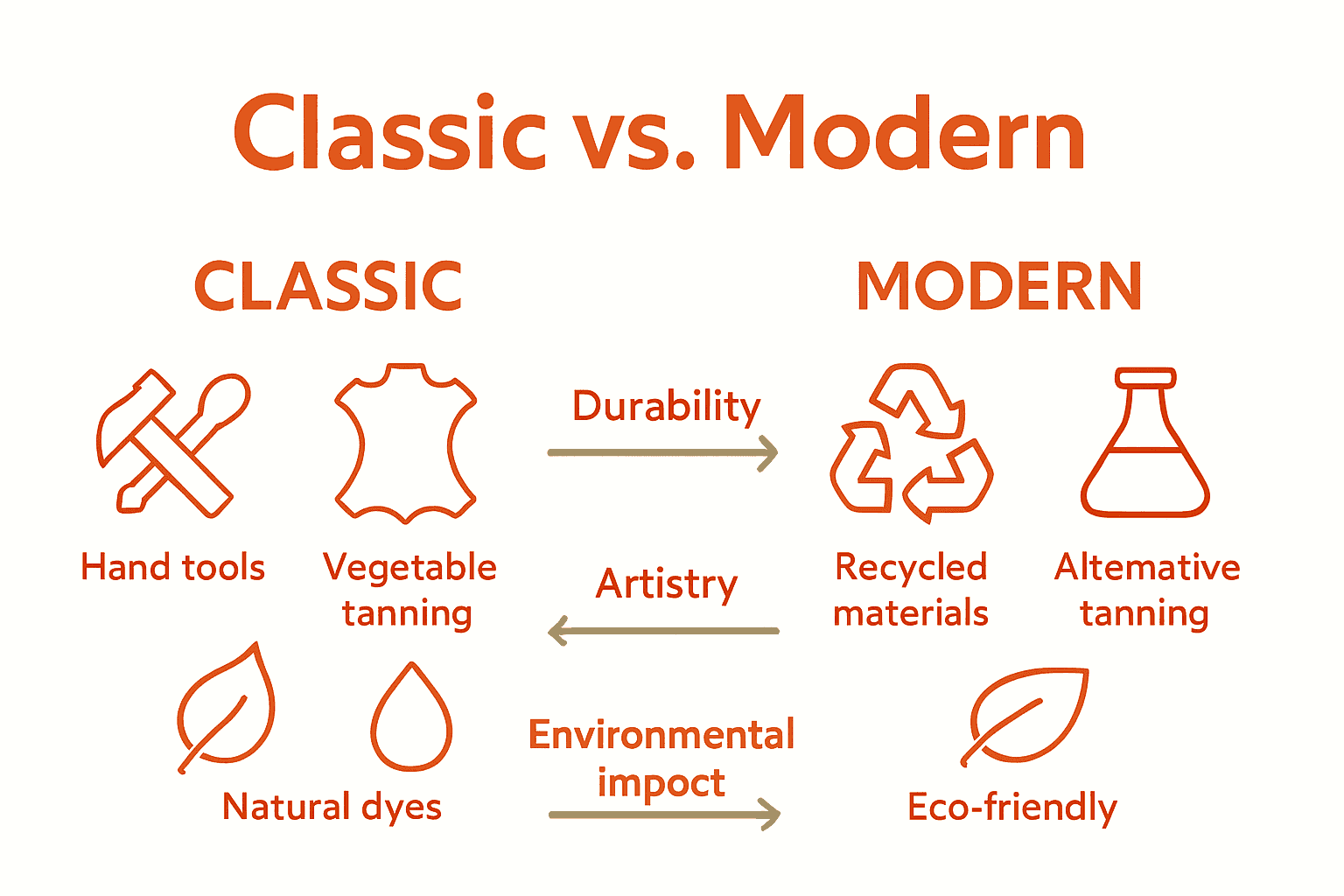
Experience True Italian Leather Craftsmanship Today
The fascinating journey from prehistoric tool techniques to iconic Italian leather designs reveals one thing clearly: quality and tradition matter deeply. If you have ever struggled to find leather goods that combine durability with authentic artisan skill, you are not alone. The article highlights how full-grain leather, vegetable tanning, and expert craftsmanship set Italian leather apart, reflecting centuries of perfected techniques and a commitment to sustainability.
At San Rocco Italia, we share this passion for excellence. Each handbag and leather accessory is crafted in Italy by skilled artisans who use premium full-grain leather and timeless methods. This ensures you receive products that not only tell a story of heritage but also age beautifully with character and grace. Discover our carefully selected collection to experience this living tradition first-hand.
Elevate your style with leather goods that carry history, authenticity, and unparalleled quality.
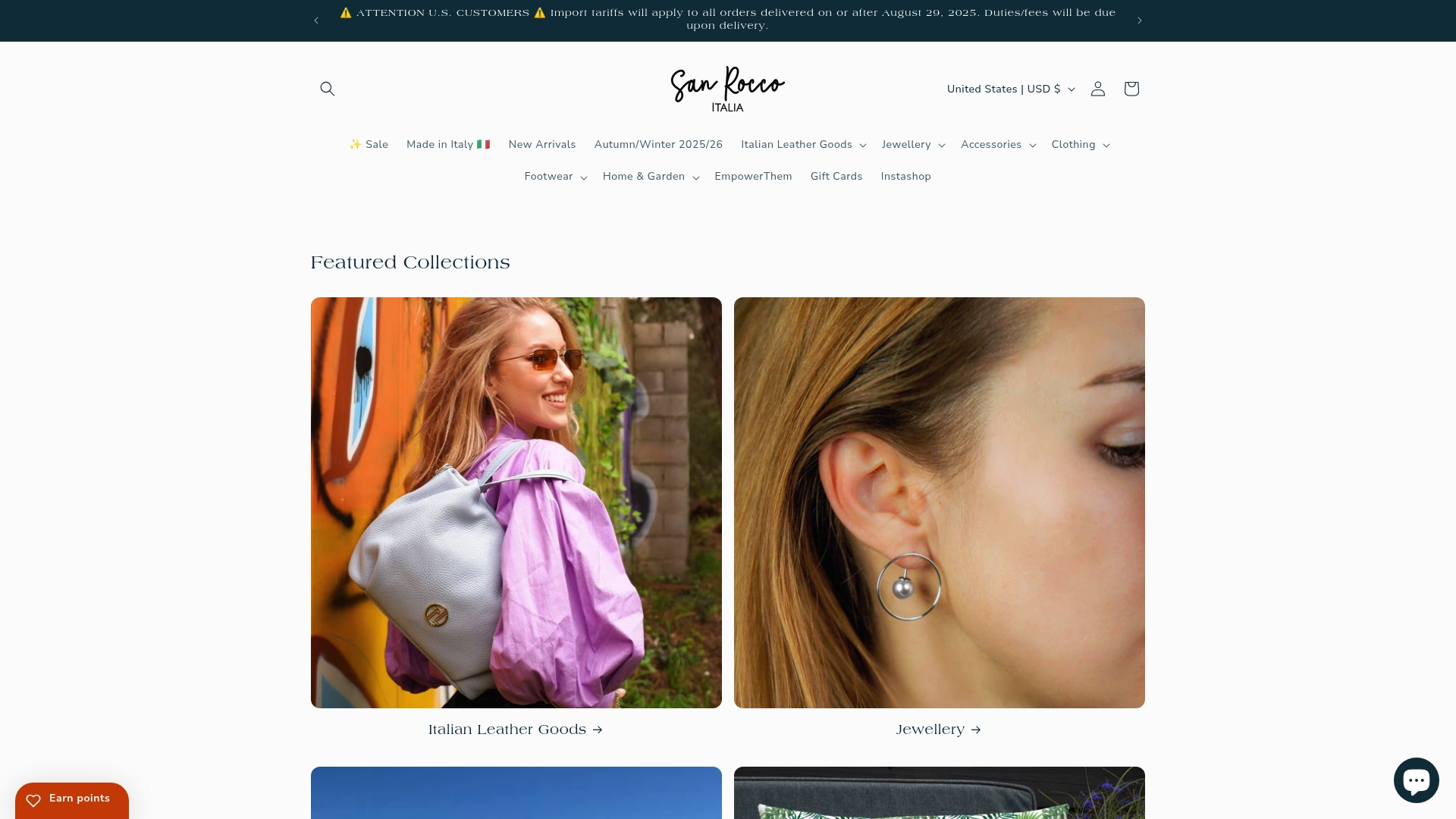
Browse our range of luxury handbags and accessories to own a piece of Italian craftsmanship. Visit San Rocco Italia now and find out why true leather lovers trust us for style that lasts. Dive deeper into the legacy by exploring how Italian leather is made naturally and learn how to identify authentic Italian leather. Your timeless leather journey starts here.
Frequently Asked Questions
What are the origins of Italian leather craftsmanship?
Italian leather craftsmanship has its roots in prehistoric times, evolving from early tool production techniques and transforming animal hides into durable materials. This tradition has been passed down through generations, influencing modern luxury design.
What defines full-grain leather and why is it valued?
Full-grain leather is the highest quality leather, retaining the entire natural grain layer and offering exceptional strength and durability. Its ability to develop a rich patina over time makes each piece unique, which is why discerning consumers prefer it.
How have traditional leather crafting techniques evolved?
Traditional leather crafting techniques have evolved through significant technological advancements, particularly in tanning, cutting, and treating leather. These innovations have allowed artisans to create exquisite materials that combine functionality with artistic expression.
What modern trends are influencing the leather industry?
Modern trends in the leather industry focus on sustainability and ethical practices, with manufacturers implementing circular economy principles and innovative production techniques. This approach aims to balance traditional craftsmanship with technological advancements for responsible production.
Recommended
- The Essential Guide to Italian Handbag Making History – San Rocco Italia
- Understanding the History of Italian Bags: A Craftsmanship Legacy – San Rocco Italia
- 8 Best Italian Leather Handbags Made in Italy to Explore – San Rocco Italia
- Understanding Italian Leather Craftsmanship: Timeless Quality – San Rocco Italia
- Understanding What is Cork Leather and Its Benefits – The Cork Store

